

The Orgasmic Brain. [Quotes from The Three-Pound Universe, 0-874-77650-3, 419 pg pb by Judith Hooper and Dick Teresi, 1986; 1991] '...If New Orleans is a city with an overripe id, it is also home to Tulane University Medical School and its unique department of neurology and psychiatry. ...
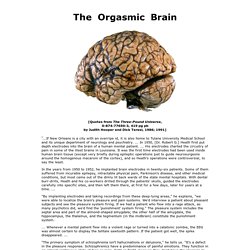
In 1950, [Dr. Robert G.] Heath first put depth electrodes into the brain of a human mental patient. ... Females seeking a sex partner can tell whether males experienced stress during adolescence. Sexual preference is influenced by males' adolescent social stress history and social status, according to a research team including Nicole Cameron, assistant professor of psychology at Binghamton University, State University of New York.

Cameron, along with Cheryl McCormick from Brock University in Ontario, Canada, tested the hypotheses that social stress in adolescence decreases the "attractiveness" of male rats as sexual partners and that dominance status is a protective factor against the effects of social stress, when it comes to finding a sexual partner. The team's main prediction was that females would spend more time with control males than stressed males, and that this bias would be greater for submissive than for dominant rats.
The team subjected a group of male rats to social stress during adolescence, forcing the rats to change cage-partners regularly and establish their dominance in a group over and over. Explore further: Fish sperm race for reproductive success.
Louann Brizendine. On the mis-presentation and misinterpretation of gender-related data: The case of Ingalhalikar’s human connectome study. Getting in a Tangle Over Men's and Women's Brain Wiring. You may have heard there’s a new study that claims to have found that men’s and women’s brains are wired differently.
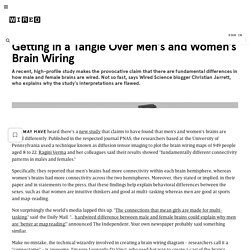
Published in the respected journal PNAS, the researchers based at the University of Pennsylvania used a technique known as diffusion tensor imaging to plot the brain wiring maps of 949 people aged 8 to 22. Ragini Verma and her colleagues said their results showed “fundamentally different connectivity patterns in males and females.”
Specifically, they reported that men’s brains had more connectivity within each brain hemisphere, whereas women’s brains had more connectivity across the two hemispheres. Moreover, they stated or implied, in their paper and in statements to the press, that these findings help explain behavioral differences between the sexes, such as that women are intuitive thinkers and good at multi-tasking whereas men are good at sports and map-reading. Not surprisingly the world’s media lapped this up. OK, one last thing. –Want to read more? Go Back to Top. On the mis-presentation and misinterpretation of gender-related data: The case of Ingalhalikar’s human connectome study.
Equal ≠ The Same: Sex Differences in the Human Brain. Early in 2013, the Food and Drug Administration (FDA) ordered the makers of the well-known sleep aid Ambien (zolpidem) to cut their recommended dose in half-but only for women.
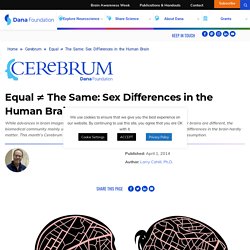
In essence, the FDA was acknowledging that despite extensive testing prior to the drug's release on the market, millions of women had been overdosing on Ambien for 20 years. On February 9, 2014, CBS's 60 Minutes highlighted this fact-and sex differences in general-by powerfully asking two questions: Why did this happen, and are men and women treated equally in research and medicine?
1 The answer to the first question is that the biomedical community has long operated on what is increasingly being viewed as a false assumption: that biological sex matters little, if at all, in most areas of medicine. The answer to the second question is no, today's biomedical research establishment is not treating men and women equally. Why Sex Didn't Matter Why Sex Matters Let us start with animal research.
Sex beyond the genitalia: The human brain mosaic. Author Affiliations Edited by Bruce S.
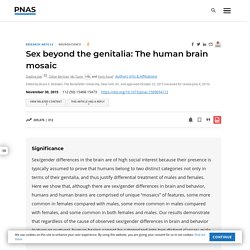
Male Brain vs. Female Brain I. Gender Differences in the Functional and Structural Neuroanatomy of Mathematical Cognition. Sex differences hippocampal volume. The human hippocampus is not sexually-dimorphic: Meta-analysis of structural MRI volumes. The functional neuroanatomy of multitasking: combining dual tasking with a short term memory task. Sex differences in the structural connectome of the human brain. Author Affiliations Edited by Charles Gross, Princeton University, Princeton, NJ, and approved November 1, 2013 (received for review September 9, 2013) Significance Sex differences are of high scientific and societal interest because of their prominence in behavior of humans and nonhuman species.
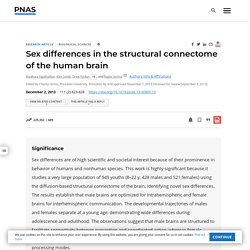
This work is highly significant because it studies a very large population of 949 youths (8–22 y, 428 males and 521 females) using the diffusion-based structural connectome of the brain, identifying novel sex differences. The results establish that male brains are optimized for intrahemispheric and female brains for interhemispheric communication. Abstract Sex differences in human behavior show adaptive complementarity: Males have better motor and spatial abilities, whereas females have superior memory and social cognition skills. Footnotes. Do women really have more bilateral language representation than men? A meta-analysis of functional imaging studies. Introduction.

Male and female brains wired differently, scans reveal. Scientists have drawn on nearly 1,000 brain scans to confirm what many had surely concluded long ago: that stark differences exist in the wiring of male and female brains.

Maps of neural circuitry showed that on average women's brains were highly connected across the left and right hemispheres, in contrast to men's brains, where the connections were typically stronger between the front and back regions. Ragini Verma, a researcher at the University of Pennsylvania, said the greatest surprise was how much the findings supported old stereotypes, with men's brains apparently wired more for perception and co-ordinated actions, and women's for social skills and memory, making them better equipped for multitasking. "If you look at functional studies, the left of the brain is more for logical thinking, the right of the brain is for more intuitive thinking. So if there's a task that involves doing both of those things, it would seem that women are hardwired to do those better," Verma said. Sex beyond the genitalia: The human brain mosaic.
The brains of men and women aren’t really that different, study finds. In the mid-19th century, researchers claimed they could tell the sex of an individual just by looking at their disembodied brain.

But a new study finds that human brains do not fit neatly into “male” and “female” categories. Indeed, all of our brains seem to share a patchwork of forms; some that are more common in males, others that are more common in females, and some that are common to both. The findings could change how scientists study the brain and even how society defines gender. “Nobody has had a way of quantifying this before,” says Lise Eliot, a neuroscientist at Chicago Medical School in Illinois who was not involved in the study. “Everything they’ve done here is new.” As soon as scientists could image the brain, they began hunting for sex differences. So in the new study, researchers led by Daphna Joel, a behavioral neuroscientist at Tel Aviv University in Israel, tried to be as comprehensive as possible.
The team found a few structural differences between men and women.